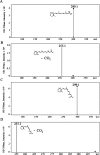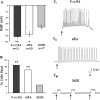Detection of endogenous retinoids in the molluscan CNS and characterization of the trophic and tropic actions of 9-cis retinoic acid on isolated neurons
- PMID: 19036995
- PMCID: PMC6671795
- DOI: 10.1523/JNEUROSCI.3192-08.2008
Detection of endogenous retinoids in the molluscan CNS and characterization of the trophic and tropic actions of 9-cis retinoic acid on isolated neurons
Abstract
Retinoic acid (RA) is an active metabolite of Vitamin A that plays an important role in the growth and differentiation of many cell types. All-trans RA (atRA) is the retinoic acid isomer that has been most widely studied in the nervous system, and can induce and direct neurite outgrowth from both vertebrate and invertebrate preparations. The presence and role of the 9-cis-RA isomer in the nervous system is far less well defined. Here, we used high-pressure liquid chromatography (HPLC) and mass spectrometry (MS) to show for the first time, the presence of both atRA and 9-cis-RA in the CNS of an invertebrate. We then demonstrated that 9-cis-RA was capable of exerting the same neurotrophic and chemotropic effects on cultured neurons as atRA. In this study, significantly more cells showed neurite outgrowth in 9-cis-RA versus the EtOH vehicle control, and 9-cis-RA significantly increased the number and length of neurites from identified neurons after 4 d in culture. 9-cis-RA also extended the duration of time that cells remained electrically excitable in culture. Furthermore, we showed for the first time in any species, that exogenous application of 9-cis-RA induced positive growth cone turning of cultured neurons. This study provides the first evidence for the presence of both atRA and 9-cis-RA in an invertebrate CNS and also provides the first direct evidence for a potential physiological role for 9-cis-RA in neuronal regeneration and axon pathfinding.
Figures








Similar articles
-
Retinoic acid induces neurite outgrowth and growth cone turning in invertebrate neurons.Dev Biol. 2006 Jun 1;294(1):39-49. doi: 10.1016/j.ydbio.2006.02.018. Epub 2006 Apr 19. Dev Biol. 2006. PMID: 16626686
-
A novel, nongenomic mechanism underlies retinoic acid-induced growth cone turning.J Neurosci. 2009 Nov 11;29(45):14136-42. doi: 10.1523/JNEUROSCI.2921-09.2009. J Neurosci. 2009. PMID: 19906962 Free PMC article.
-
Combined use of bFGF/EGF and all-trans-retinoic acid cooperatively promotes neuronal differentiation and neurite outgrowth in neural stem cells.Neurosci Lett. 2019 Jan 18;690:61-68. doi: 10.1016/j.neulet.2018.10.002. Epub 2018 Oct 6. Neurosci Lett. 2019. PMID: 30300683
-
Role of all-trans retinoic acid in neurite outgrowth and axonal elongation.J Neurobiol. 2006 Jun;66(7):739-56. doi: 10.1002/neu.20241. J Neurobiol. 2006. PMID: 16688769 Review.
-
Dynamic regulation of axon guidance.Nat Neurosci. 2001 Nov;4 Suppl:1169-76. doi: 10.1038/nn748. Nat Neurosci. 2001. PMID: 11687826 Review.
Cited by
-
Molluscan cells in culture: primary cell cultures and cell lines.Can J Zool. 2013 Jun 1;91(6):10.1139/cjz-2012-0258. doi: 10.1139/cjz-2012-0258. Can J Zool. 2013. PMID: 24198436 Free PMC article.
-
Inhibition of Rho GTPases in Invertebrate Growth Cones Induces a Switch in Responsiveness to Retinoic Acid.Biomolecules. 2019 Sep 7;9(9):460. doi: 10.3390/biom9090460. Biomolecules. 2019. PMID: 31500289 Free PMC article.
-
Establishment of a polyclonal antibody against the retinoid X receptor of the rock shell Thais clavigera and its application to rock shell tissues for imposex research.Ecotoxicology. 2010 Mar;19(3):571-6. doi: 10.1007/s10646-009-0447-6. Epub 2009 Dec 4. Ecotoxicology. 2010. PMID: 19960246
-
Presence of Ribeiroia ondatrae in the developing anuran limb disrupts retinoic acid levels.Parasitol Res. 2012 Jan;110(1):49-59. doi: 10.1007/s00436-011-2451-z. Epub 2011 May 26. Parasitol Res. 2012. PMID: 21614545
-
Evolutionary origins of retinoid active short-chain dehydrogenases/reductases of SDR16C family.Chem Biol Interact. 2015 Jun 5;234:135-43. doi: 10.1016/j.cbi.2014.10.026. Epub 2014 Nov 1. Chem Biol Interact. 2015. PMID: 25451586 Free PMC article.
References
-
- Barua AB, Furr HC. Properties of retinoids. Structure, handling, and preparation. Methods Mol Biol. 1998;89:3–28. - PubMed
-
- Biesalski HK, Doepner G, Tzimas G, Gamulin V, Schröder HC, Batel R, Nau H, Müller WE. Modulation of myb gene expression in sponges by retinoic acid. Oncogene. 1992;7:1765–1774. - PubMed
-
- Bouton D, Escriva H, deMendonca R, Glineur C, Bertin B, Noel C, Robinson- Rechavi M, de Groot A, Cornette J, Laudet V, Pierce R. A conserved retinoid X receptor (RXR) from the mollusk Biomphalaria glabrata transactivates transcription in the presence of retinoids. J Mol Endocrin. 2005;34:567–582. - PubMed
-
- Brodeur H, Parisotto M, Chagnon S, Mader S, Bhat PV. Isomer-specific retinoic acid biosynthesis in HeLa cells expressing recombinant class I aldehyde dehydrogenases. Biochim Biophys Acta. 2007;1770:1548–1556. - PubMed
-
- Chambon P. A decade of molecular biology of retinoic acid receptors. FASEB J. 1996;10:940–954. - PubMed
Publication types
MeSH terms
Substances
LinkOut - more resources
Full Text Sources
Other Literature Sources
